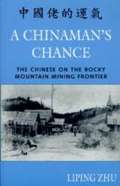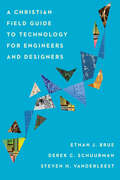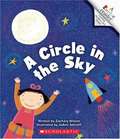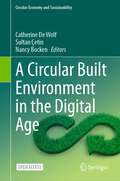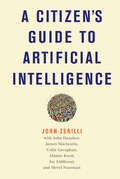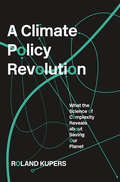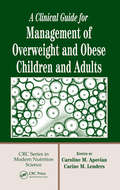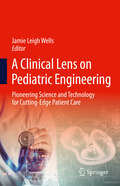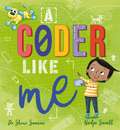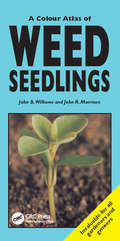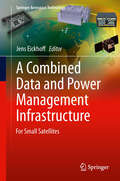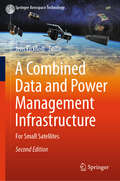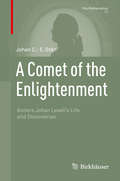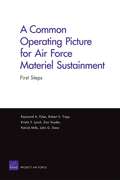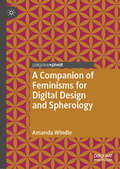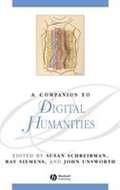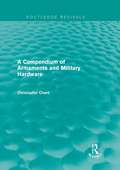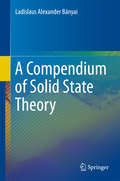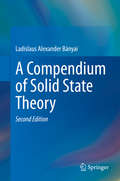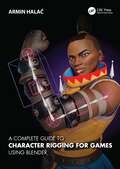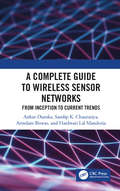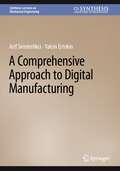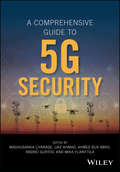- Table View
- List View
A Chinaman's Chance: The Chinese on the Rocky Mountain Mining Frontier
by Liping ZhuIn 1880, what was it like to be Chinese and work in the mines around Boise? This book answers those questions..
A Christian Field Guide to Technology for Engineers and Designers
by Derek C. Schuurman Ethan J. Brue Steven H. VanderLeestOur technology shapes the way we live, interact, work, play, and even worship.biblical themes and passages that relate to technologythe ethics and norms involved in technology designhow engineering and technology tap into human dreams for a better worldAlong the way they acknowledge the challenges arising from technology but also point to the wonderful possibilities it offers us and its ability to contribute to the common good. For Christians studying and working in engineering, computer science, technical design, architecture, and related fields, this book is packed with wisdom and practical guidance. By sharing what they have learned, the authors encourage readers to ask harder questions, aspire to more noble purposes, and live a life consistent with their faith as they engage with technology.
A Circle in the Sky
by Zachary WilsonA child puts together various simple shapes to build a rocket that will fly to the moon.
A Circular Built Environment in the Digital Age (Circular Economy and Sustainability)
by Catherine De Wolf Nancy Bocken Sultan ÇetinThis open access book offers a comprehensive exploration of the digital innovations that have emerged in recent years for the circular built environment. Each chapter is meticulously crafted to ensure that both academic readers and industry practitioners can grasp the inner workings of each digital technology, understand its relevance to the circular built environment, examine real-life implementations, and appreciate the intriguing business models behind them. Our primary objective is to blend scholarly knowledge with practical inspiration by providing real-life case studies for each innovation. The authors, who possess extensive expertise in their respective fields, have contributed chapters dedicated to digital technologies within their areas of specialization. The book is organized into three distinct parts. The first part focuses on data-driven digital technologies and delves into how their capabilities can facilitate the transition to a circular built environment. Essential aspects such as building information modeling (BIM), digital twins, geographical information systems (GIS), scanning technologies, artificial intelligence (AI), data templates, and material passports are explored as vital tools for data collection, integration, and analysis in the context of circular construction. In the second part, various digital technologies for design and fabrication are introduced. Topics covered include computational design algorithms, additive and subtractive manufacturing, robotic manufacturing, and extended reality. These discussions shed light on how these technologies can be leveraged to enhance design and fabrication processes within the circular built environment. Finally, the last part of the book presents emerging digital concepts related to business and governance. It explores the role of deconstruction and reverse logistics, blockchain technology, digital building logbooks, and innovative business models as enablers of circularity in the built environment. The book concludes with a chapter dedicated to digital transformation and its potential to propel the built environment towards a regenerative future. In addition to the substantive content, the book features forewords and perspectives from esteemed experts, providing valuable economic and creative insights to complement its comprehensive approach.
A Citizen's Guide to Artificial Intelligence
by John ZerilliA concise but informative overview of AI ethics and policy.Artificial intelligence, or AI for short, has generated a staggering amount of hype in the past several years. Is it the game-changer it's been cracked up to be? If so, how is it changing the game? How is it likely to affect us as customers, tenants, aspiring home-owners, students, educators, patients, clients, prison inmates, members of ethnic and sexual minorities, voters in liberal democracies? This book offers a concise overview of moral, political, legal and economic implications of AI. It covers the basics of AI's latest permutation, machine learning, and considers issues including transparency, bias, liability, privacy, and regulation.
A Climate Policy Revolution: What the Science of Complexity Reveals about Saving Our Planet
by Roland KupersHumanity’s best hope for confronting the looming climate crisis rests with the new science of complexity. The sheer complexity of climate change stops most solutions in their tracks. How do we give up fossil fuels when energy is connected to everything, from great-power contests to the value of your pension? Global economic growth depends on consumption, but that also produces the garbage now choking the oceans. To give up cars, coal, or meat would upend industries and entire ways of life. Faced with seemingly impossible tradeoffs, politicians dither and economists offer solutions at the margins, all while we flirt with the sixth extinction. That’s why humanity’s last best hope is the young science of complex systems. Quitting coal, making autonomous cars ubiquitous, ending the middle-class addiction to consumption: all necessary to head off climate catastrophe, all deemed fantasies by pundits and policymakers, and all plausible in a complex systems view. Roland Kupers shows how we have already broken the interwoven path dependencies that make fundamental change so daunting. Consider the mid-2000s, when, against all predictions, the United States rapidly switched from a reliance on coal primarily to natural gas. The change required targeted regulations, a few lone investors, independent researchers, and generous technology subsidies. But in a stunningly short period of time, shale oil nudged out coal, and carbon dioxide emissions dropped by 10 percent. Kupers shows how to replicate such patterns in order to improve transit, reduce plastics consumption, and temper the environmental impact of middle-class diets. Whether dissecting China’s Ecological Civilization or the United States’ Green New Deal, Kupers describes what’s folly, what’s possible, and which solutions just might work.
A Clinical Guide for Management of Overweight and Obese Children and Adults (Modern Nutrition Science)
by Caroline M. Apovian Carine M. LendersWhile unhealthy diet and sedentary behaviors are second only to smoking as the leading preventable cause of death in the U.S., less than 45 percent of adult and pediatric obese patients received any prior advice from a physician to lose weight. The low rate of identification and treatment of obesity by physicians can often be attributed to lack of
A Clinical Lens on Pediatric Engineering: Pioneering Science and Technology for Cutting-Edge Patient Care
by Jamie Leigh WellsA Clinical Lens on Pediatric Engineering: Pioneering Science and Technology for Cutting-Edge Patient Care explores the depth and breadth of the newly applied science of pediatric engineering and its dawning era. Placing into context the origins of pediatric medicine and engineering, this deep dive into and beyond medical digital-to-device innovation integrates scientific rigor with clinical perspective, incorporating case examples of diagnostic and therapeutic breakthroughs, cautionary tales, and lessons in translation. The book begins by explaining the unique considerations of the developing child and the importance of including nuanced end-user and human factors early and often in the process of seeking biomedical solutions. It provides an overview of this population's diverse and dynamic biopsychosocial characteristics compared to adults, contrasting organ systems, cognitive maturation, bioethics, growth, and drug metabolism. A distinguished team of contributors supplies a comprehensive blueprint for transforming an idea through to clinical implementation, featuring the ever-expanding influences and intricacies of discovery. The book covers a wide array of topics, including fetal intervention, transplantation, regenerative medicine, addiction, ophthalmology, surgery (e.g., minimally invasive, orthopedic), cancer, nanotechnology, radiology imaging modalities, gene therapy, artificial intelligence (AI), machine learning, liquid biopsy, immersive technologies (e.g., augmented and virtual reality), neurodiversity, rare disease, critical care, robotics, materials science and tissue engineering. The design challenges specific to children’s hospitals and healthcare facilities are discussed, highlighting the flexibility needed to achieve optimal patient outcomes, gather meaningful data, and drive innovative progress. This landmark work calls on key stakeholders to address the obstacles related to funding practices, clinical trials, and other impediments that hinder the timely and safe delivery of life-altering and life-saving results. It provides child health innovators with the essential tools to bridge these gaps and drive transformation in the rapidly evolving landscape of pediatric care.
A Coder Like Me
by Dr Shini SomaraEngaging illustrations and an empowering story combine to introduce young readers to the world of coding, computers and problem-solving.Curious Sam has lots of questions. What is an algorithm? Could a robot be instructed to walk a dog? What is artificial intelligence? A day spent with Auntie Jo turns into a fascinating lesson in coding for Sam! They discover that the world is full of clever computers, find out about the language they "speak" and the brilliant coders who have helped us to understand it. Maybe Sam can try out some awesome coding projects and become a coder too?With pages encouraging kids to try out coding for themselves and opening their minds to the fun things that can be created using computer code, this brilliant picture book written by engineer and TV presenter Dr Shini Somara unlocks a love of coding and computing and celebrates women in STEM.
A Colour Atlas of Weed Seedlings (Manson Ser.)
by John B WilliamsEarly recognition and control of weeds invariably leads to considerable savings in the cost of herbicides used on crops and in gardens. This atlas is an indispensable full colour photographic guide to the 40 most common weeds afflicting arable farmland and gardens. The weeds have all been photographed at cotyledon and seedling stage to permit early
A Combined Data and Power Management Infrastructure: For Small Satellites (Springer Aerospace Technology)
by Jens EickhoffThis book describes the development and design of a unique combined data and power management infrastructure The use in small satellites gives some particular requirements to the systems like potential hardware failure robustness and handling of different types of external analog and digital interfaces. These requirements lead to a functional merge between On Board Computer and the satellite's Power Control and Distribution Unit, which results in a very innovative design and even a patent affiliation. This book provides system engineers and university students with the technical knowledge as mix between technical brochure and a user guide.
A Combined Data and Power Management Infrastructure: For Small Satellites (Springer Aerospace Technology)
by Jens EickhoffThis book describes the development and design of a unique combined data and power management infrastructure for small satellites. This new edition became necessary because in the frame of the system's impressive evolution from an academic prototype to one of today's most advanced core avionics, many elements were upgraded to their next technology generation and diverse new components complement the upgraded design. All elements are presented in updated respectively new chapters. This modular infrastructure was selected by the Swiss start-up ClearSpace SA for ESA's first mission ClearSpace-1 to remove space debris. Furthermore it is the baseline for the Thai national satellite development program and is used by an increasing number of universities worldwide for research studies.
A Comet of the Enlightenment: Anders Johan Lexell's Life and Discoveries (Vita Mathematica #17)
by Johan C.-E. SténThe Finnish mathematician and astronomer Anders Johan Lexell (1740-1784) was a long-time close collaborator as well as the academic successor of Leonhard Euler at the Imperial Academy of Sciences in Saint Petersburg. Lexell was initially invited by Euler from his native town of Abo (Turku) in Finland to Saint Petersburg to assist in the mathematical processing of the astronomical data of the forthcoming transit of Venus of 1769. A few years later he became an ordinary member of the Academy. This is the first-ever full-length biography devoted to Lexell and his prolific scientific output. His rich correspondence especially from his grand tour to Germany, France and England reveals him as a lucid observer of the intellectual landscape of enlightened Europe. In the skies, a comet, a minor planet and a crater on the Moon named after Lexell also perpetuate his memory.
A Common Operating Picture for Air Force Materiel Sustainment
by Robert S. Tripp Kristin F. Lynch Patrick Mills Don Snyder Raymond A. PylesDescribes a potential common operating system (COP) for the Air Force materiel sustainment system (MSS). The authors first develop a COP based on the principles of effects-based measures, schwerpunkt (organizational focus), decision rights, and a nonmarket economic framework, then they apply the COP to depot-level reparable component sustainment to illustrate how the COP would improve overall MSS efficiency and responsiveness.
A Companion of Feminisms for Digital Design and Spherology
by Amanda Windle<p>This book questions if spherology is a philosophy for designers, giving guidance on ways to read Spheres, how to approach the trilogy’s indexicality, and apply the key tropes and ethics of atmospheres to digital design. Each chapter includes a design-in, that is a practical entry point into the many tropes of Spheres including― bubbles, globes and foam. The book also applies spherology to an atmosphere design issue involving endangered species and geospatial threats to the environment. <p>Spherology refers to the Spheres trilogy by the philosopher Peter Sloterdijk, which traces spherical ideas, theories, sensations and feelings related to the philosophical concept of ‘being’ and the human-centered position of ‘being-in’. It is the first cynical, feminist companion of spherology to take a practice-led approach and to cover all three controversial volumes to with and against Spheres. Windle draws on feminist science and technology studies (STS) through parody within reading, writing and design practices. Design provides navigation so that academics and students can engage with spherology through an embodied concern with digital materiality. <p>As a feminist companion for today’s design issues, the book is an essential read for feminist STS scholars, design practitioners and digital R&D specialists working both in industry and academia, including more specifically data visualisers, interface and interaction designers.</p>
A Companion to Digital Humanities
by Susan Schreibman Ray Siemens John UnsworthThis Companion offers overview of the emerging field of humanities computing. Major sections focus on the experience of particular disciplines in applying computational methods to research problems; the basic principles of humanities computing and archiving.
A Compendium of Armaments and Military Hardware (Routledge Revivals)
by Christopher ChantFirst published in 1987, The Compendium of Armaments and Military Hardware provides, within a single volume, the salient technical and operational details of the most important weapons. The complete range of hardware used in land, sea and air forces throughout the world at the time of publication is covered, from tanks to rocket systems, helicopters to cruise missiles, alongside full details of size, weight and operational range. The book’s main strength lies in the detail it gives of armament and associated ammunition capabilities, and of the sensors and other electronics required for the weapons to be used effectively. A key title amongst Routledge reference reissues, Christopher Chant’s important work will be of great value to students and professionals requiring a comprehensive and accessible reference guide, as well as to weapons ‘buffs’.
A Compendium of Solid State Theory
by Ladislaus Alexander BányaiDesigned to sit alongside more conventional established condensed matter physics textbooks, this compact volume offers a concise presentation of the principles of solid state theory, ideal for advanced students and researchers requiring an overview or a quick refresher on a specific topic.The book starts from the one-electron theory of solid state physics, moving through electron-electron interaction and many-body approximation schemes, to lattice oscillations and their interactions with electrons. Subsequent chapters discuss transport theory and optical properties, phase transitions and some properties of low-dimensional semiconductors. Throughout the text, mathematical proofs are often only sketched, and the final chapter of the book reviews some of the key concepts and formulae used in theoretical physics.Aimed primarily at graduate and advanced undergraduate students taking courses on condensed matter theory, the book serves as a study guide to reinforce concepts learned through conventional solid state texts. Researchers and lecturers will also find it a useful resource as a concise set of notes on fundamental topics.
A Compendium of Solid State Theory
by Ladislaus Alexander BányaiDesigned to sit alongside more conventional established condensed matter physics textbooks, this compact volume offers a concise presentation of the principles of solid state theory, ideal for advanced students and researchers requiring an overview or a quick refresher on a specific topic.The book starts from the one-electron theory of solid state physics, moving through electron-electron interaction and many-body approximation schemes, to lattice oscillations and their interactions with electrons. Subsequent chapters discuss transport theory and optical properties, phase transitions and some properties of low-dimensional semiconductors. This extensively expanded second edition includes new material on adiabatic perturbation theory, kinetic coefficients, the Nyquist theorem, Bose condensation, and the field-theoretical approach to non-relativistic quantum electrodynamics. Throughout the text, mathematical proofs are often only sketched, and the final chapter of the book reviews some of the key concepts and formulae used in theoretical physics.Aimed primarily at graduate and advanced undergraduate students taking courses on condensed matter theory, the book serves as a study guide to reinforce concepts learned through conventional solid state texts. Researchers and lecturers will also find it a useful resource as a concise set of notes on fundamental topics.
A Compendium of Unique and Rare Spices: Global Economic Potential
by Kodoth Prabhakaran NairThis book is a compendium of rare and unique spices, which have been least researched but hold immense economic potential on a global scale. They are Aniseed, Shallot, Saffron, Caraway or Siah Zira, European or Indian Dill, Poppy, Star Anise and Japanese Star Anise, Sage, Savory, Tarragon, Thyme, Calamus or Sweet Flag, Horse Radish, Galangal, and Long Pepper or Pipli. Some of these are seed spices and others, like Saffron, are grown in the hills of Jammu and Srinagar, India and have varied uses, ranging from being very popular food flavorants to being used for religious purposes. Even within India, the country of the origin for most of the spices listed, many Indians are simply unaware of their immense economic potential. This is also the case with other countries, like Iran, where some spices, like Saffron, is widely used as a food flavorant. The book aims to be a unique compendium of these rare and unique spices to primarily enable researchers to tap into their great economic potential and, on a wider scale, help developmental agencies to tap into their immense potential in global spice trade. The book provides a cross-sectoral multi-scale assessment of developmental possibilities, globally, for rare and unique spices of immense economic importance.
A Complete Guide to Character Rigging for Games Using Blender
by Armin HalačThis book is a comprehensive guide to using Blender to create character rigs for games, breaking down the technicalities of rigging tools and techniques into easily digestible chunks. It provides all the tools needed to go from a static character model to an animation-ready, high quality, and fast performing game rig. Written to be accessible and easy to follow, the book covers character rigging theory that is supported by industry standard examples of how to apply that theory to character rigs for video games. It demonstrates the reasoning behind rigging decisions followed by instructions and examples on how to apply that knowledge to rig creation. It includes chapters that focus on the character deformation techniques that raise the visual quality of the model and subsequently of the animation and game it will be used in. This book will be vital reading to those studying games animation as well as early-career rigging artists, character animators, modeling artists, technical animators, and technical artists.
A Complete Guide to Wireless Sensor Networks: from Inception to Current Trends
by Arindam Biswas Ankur Dumka Sandip K. Chaurasiya Hardwari Lal MandoriaThis book provides comprehensive coverage of the major aspects in designing, implementing, and deploying wireless sensor networks by discussing present research on WSNs and their applications in various disciplines. It familiarizes readers with the current state of WSNs and how such networks can be improved to achieve effectiveness and efficiency. It starts with a detailed introduction of wireless sensor networks and their applications and proceeds with layered architecture of WSNs. It also addresses prominent issues such as mobility, heterogeneity, fault-tolerance, intermittent connectivity, and cross layer optimization along with a number of existing solutions to stimulate future research.
A Comprehensive Approach to Digital Manufacturing (Synthesis Lectures on Mechanical Engineering)
by Arif Sirinterlikci Yalcin ErtekinThis book draws a comprehensive approach to digital manufacturing through computer-aided design (CAD) and reverse engineering content complemented by basic CNC machining and computer-aided manufacturing (CAM), 3D printing, and additive manufacturing (AM) knowledge. The reader is exposed to a variety of subjects including the history, development, and future of digital manufacturing, a comprehensive look at 3D printing and AM, a comparative study between 3D printing and AM and CNC machining, and computer-aided engineering (CAE) along with 3D scanning. Applications of 3D printing and AM are presented as well as multiple special topics including design for 3D printing and AM (DfAM), costing, sustainability, environmental, safety, and health (EHS) issues. Contemporary subjects such as bio-printing, intellectual property (IP) and engineering ethics, virtual prototyping including augmented, virtual, and mixed reality (AR/VR/MR), and industrial Internet of Things (IIoT) are also covered.Each chapter comes with in-practice exercises and end-of-chapter questions, which can be used as home-works as well as hands-on or software-based laboratory activities. End-of-chapter questions are of three types mainly: review questions which can be answered by reviewing each chapter, research questions which need to be answered by conducting literature reviews and additional research, and discussion questions. In addition, some of the chapters include relevant problems or challenges which may require additional hands-on efforts. Most of the hands-on and practical content is driven by the authors’ previous experiences. The authors also encourage readers to help improve this book and its exercises by contacting them.
A Comprehensive Guide to 5G Security
by Andrei Gurtov Madhusanka Liyanage Mika Ylianttila Ijaz Ahmad Ahmed Bux AbroThe first comprehensive guide to the design and implementation of security in 5G wireless networks and devices Security models for 3G and 4G networks based on Universal SIM cards worked very well. But they are not fully applicable to the unique security requirements of 5G networks. 5G will face additional challenges due to increased user privacy concerns, new trust and service models and requirements to support IoT and mission-critical applications. While multiple books already exist on 5G, this is the first to focus exclusively on security for the emerging 5G ecosystem. 5G networks are not only expected to be faster, but provide a backbone for many new services, such as IoT and the Industrial Internet. Those services will provide connectivity for everything from autonomous cars and UAVs to remote health monitoring through body-attached sensors, smart logistics through item tracking to remote diagnostics and preventive maintenance of equipment. Most services will be integrated with Cloud computing and novel concepts, such as mobile edge computing, which will require smooth and transparent communications between user devices, data centers and operator networks. Featuring contributions from an international team of experts at the forefront of 5G system design and security, this book: Provides priceless insights into the current and future threats to mobile networks and mechanisms to protect it Covers critical lifecycle functions and stages of 5G security and how to build an effective security architecture for 5G based mobile networks Addresses mobile network security based on network-centricity, device-centricity, information-centricity and people-centricity views Explores security considerations for all relative stakeholders of mobile networks, including mobile network operators, mobile network virtual operators, mobile users, wireless users, Internet-of things, and cybersecurity experts Providing a comprehensive guide to state-of-the-art in 5G security theory and practice, A Comprehensive Guide to 5G Security is an important working resource for researchers, engineers and business professionals working on 5G development and deployment.
